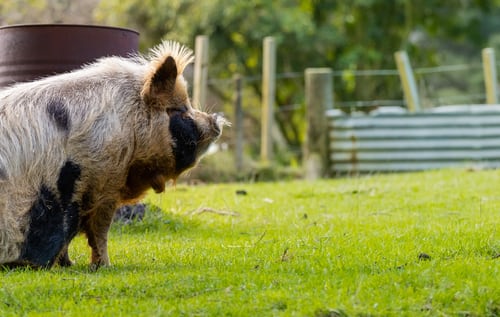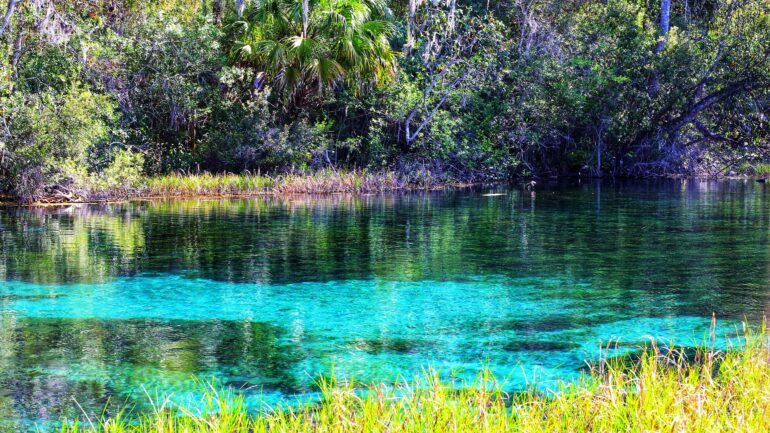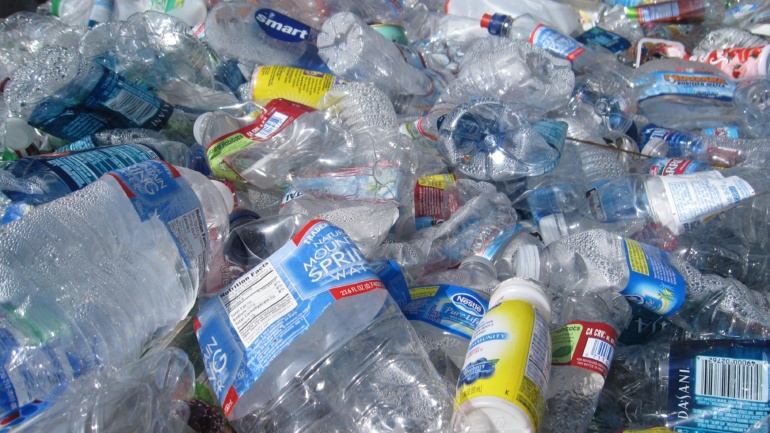By Rachel Porter, Staff Writer & Researcher for Save The Water™ | January 20, 2018
At the end of the holiday season, few can look back on festive memories and past feasts without picturing the traditional table centerpiece: the holiday ham. However, rarely do we stop to think about the feces and waste produced before the hog reached the table or the water quality risks that come along with it. Although at first glance these risks can seem daunting, change is on the horizon.
Hog Farms in the United States
Presently, the pork industry has a looming presence in the United States with over 71 million hogs on “concentrated animal feeding operations,” also known as CAFOs.1 Coupled with this large size is a waste management system that poses numerous and direct threats to precious ground, surface, and drinking water.
Particularly, many risks stem from the shift of CAFOs over the past 50 years towards specialization and consolidation. Instead of small farmers overseeing all steps of pork production, separate facilities now specialize in each stage. For example, there is one facility for breeding, one for raising hogs, and one for slaughtering and finishing operations.2 Instead of smaller, privately owned farms, four large corporations control nearly 70% of the market.3 These CAFOs can house thousands to hundreds-of-thousands of hogs in very small, concentrated spaces. As a result, these farms must deal with the large volume of waste that come with them.4 And it’s a lot of waste.
Hog Waste Lagoons
An individual hog can produce 4 to 8 times as much feces as an individual human.2 Generally, humans flush all their waste down a toilet to a sewage treatment facility. Thereafter, mechanical and chemical treatment removes many contaminants before it is released into the environment. Meanwhile, hog waste is not subjected to this treatment process.2,4 Rather, most CAFOs keep the hogs in small stalls with little to no room to move or lie down. Here the hogs stand, eat, and discard their waste into the slatted floors beneath them. Then this waste is pumped in a “liquid slurry” to large open air pits called lagoons.5
For pits full of feces, “stillborn pigs, afterbirths, pesticides, [and] blood,” hog lagoons appear deceptively pretty. The light pink amalgam of waste products houses thousands of contaminants that can enter water systems where they pose a direct threat to human health.5 Most notable are pathogens, nutrients, heavy metals, and antibiotics. While some of these contaminants are naturally occurring, farmers add others to hog feed where they enter the hogs’ digestive systems. Then the hogs excrete these contaminants into their waste, and the contaminants subsequently end up the lagoons.
Naturally Occurring Lagoon Contaminants from Hog Waste
Pathogens
Pathogens are agents, such as bacteria or viruses, that cause diseases.6 While feces, hog or human, naturally contain bacteria, hog waste can contain 100 to 10,000 times the number of pathogens than are allowed in treated human waste. For instance, E. coli, salmonella, and streptocolli are common pathogens in lagoons, and can cause moderate symptoms from diarrhea and vomiting to more serious illnesses such as kidney failure, neurological damage, or death.4
Nutrients
Similarly, feces also naturally contain nutrients such as phosphorus and nitrogen. Nonetheless, in large concentrations these nutrients can cause human health problems. For example, high concentrations of nitrates (more than 10mg per liter) in drinking water are associated with illnesses like blue baby syndrome, which can lead to infant mortality; insulin dependent-diabetes; and central nervous system malfunctions.4,7
Dangerous Industry Additives to Hog Waste
Heavy Metals
On the other hand, farmers often directly add heavy metals including arsenic, copper, and selenium to hog feed to promote growth. Moreover, heavy metals can also enter the hogs digestive system through the ingestion of pesticides.4,7 High concentrations of these elements can cause serious human illness. For example, arsenic can cause various cancers and vascular complication, while selenium can cause liver dysfunction and hair loss.4
Antibiotics and Antibiotic-Resistant Diseases
Lastly, antibiotics and antibiotic-resistant diseases present additional risks. Specifically, farmers feed hogs large quantities of antibiotics to increase growth or prevent, rather than treat, illness. In the United States farmers give nearly 25 million pounds of antibiotics to livestock for “non-therapeutic purposes,” while Americans take only 3 million to treat human illnesses.4
Because large amounts of antibiotics promote the spread of dangerous, antibiotic-resistant diseases that are hard, costly, or impossible to treat, this poses a major threat to human health.8 Up to 80% of the antibiotics can pass through the hogs’ digestive systems where the drugs and resistant bacteria enter into the lagoons.4
Mechanisms of Water Quality Threat
Even under normal operating conditions, these lagoons and their contaminants pose a threat to human health. Hog lagoons risk dumping millions of gallons of hog waste into ground, surface, and drinking water systems through three mechanisms.
First, sludge in the lagoons is periodically applied as a fertilizer on crops called “spray fields.” Although feces can be a beneficial fertilizer with many essential nutrients, over-application is common because of the large volume of lagoon waste. Fields and soils then become saturated. Subsequently, excess nutrients, with the mix of other harmful pathogens, metals, and bacteria, run off into ground and surface waters.7
Second, leaks, seepage, or bursts in the structural design of the lagoons also pose a health risk. Although new regulations require lagoons to include linings of plastic, concrete, or clay, many decades-old lagoons were constructed before these requirements. Furthermore, even with linings, leaks can occur. For example, a study in Kansas found that leaks in just four lagoons released up to 4.35 million gallons of hog waste every year.4
Lastly, rains and floods present still more risks. When hurricanes or heavy rains occur, lagoons are at risk of bursting or overflowing. If they burst, they release their contaminants into the flood waters which can be washed miles away into surface waters. Moreover, the burst lagoons can leak into saturated soils where they can contaminate groundwater or vulnerable aquifers.
For example, in 1999 Hurricane Floyd hit North Carolina and structurally damaged 6 lagoons while flooding 55 others.4 Despite improvements made since, this issue continues to occur. Most recently, Hurricane Florence resulted in at least three lagoons bursts and six confirmed reports of structural damage.9
Inadequate Hog Waste Lagoon Regulation and Policy
Although storms such as Floyd, Mathew, and Florence have put a spotlight on these outdated and failing lagoon systems, the industry has made little substantive progress.
For instance, following Floyd in 1999, North Carolina allocated 18 million dollars to move hog farms out of the 100-year floodplain. However, this didn’t solve the problem. Hurricane Matthew in 2016 was considered a 500-year flood, and Hurricane Florence in 2018 was considered a 1,000-year flood. Moreover, 60 CAFOs in North Carolina still sit in the 100-year floodplain with thousands of lagoons along the state’s vulnerable coastline.10
Additionally, in 2007 North Carolina banned new lagoon construction and provided financial incentives for CAFOs to install environmentally superior technologies (ESTs). These ESTs would “substantially reduce… and prevent waste discharges into surface and ground waters.” However, this law did not address existing lagoons, and only 8 of the 2,200 hog farms in North Carolina participated in the technology upgrades.2
Going Forward: 3 Things You Can Do To Help
In sum, the hog waste management system has remained almost completely unchanged for over 20 years. This system results from a combination of inefficient policy, unenforced regulations, and outdated technology.5 Still, change is possible.
Markedly, many new technologies and sustainable agricultural practices aim to mitigate and manage animal waste and alleviate contamination risks.4 At this time, many individual farms and farmers across the nation have taken the initiative to implement these innovations.
Moreover, consumers always hold the most power. Particularly, here are three things you can do to be part of the solution:
- Be a conscious consumer: choose farms and companies that practice sustainable agriculture. For example, choose meat products raised without the use of antibiotics.
- Eat less meat: by consuming less meat, every person can help reduce the number of animals in production and thus the amount of waste that threatens to contaminate water systems.
- Monitor local drinking water: identify possible sources of hog waste contamination to nearby water systems and check drinking water contamination levels regularly, especially if you consume private well water.
References
- Cheryl Day. June 30, 2017. “How fast is the U.S. pig industry growing?” National Hog Farmer. https://www.nationalhogfarmer.com/marketing/how-fast-us-pig-industry-growing
- Wendee Nicole. June, 2013. “CAFOs and Environmental Justice: The Case of North Carolina.” Environmental Health Perspectives, 121(6), a182-a189. https://www.ncbi.nlm.nih.gov/pmc/articles/PMC3672924/
- Duke Center on Globalization, Governance and Competitiveness. “North Carolina in the Global Economy: Hog Farming.” http://www.ncglobaleconomy.com/NC_GlobalEconomy/hog/overview.shtml
- Robbin Marks. July, 2001. “Cesspools of Shame: How Factory Farm Lagoons and Sprayfields Threaten Environmental and Public Health.” Natural Resources Defense Council and the Clean Water Network. https://www.nrdc.org/sites/default/files/cesspools.pdf
- Emily Moon. September 14, 2018. “North Carolina’s Hog Waste Problem Has a Long History. Why Wasn’t It Solved in Time for Hurricane Florence?” Pacific Standard Magazine. https://psmag.com/environment/why-wasnt-north-carolinas-hog-waste-problem-solved-before-hurricane-florence
- Merriam-webster. “pathogen.” https://www.merriam-webster.com/dictionary/pathogen
- JoAnn Burkholder, et al. February, 2007. “Impacts of Waste from Concentrated Animal Feeding Operations on Water Quality.” Environmental Health Perspectives, 115(2), 308-312. https://www.ncbi.nlm.nih.gov/pmc/articles/PMC1817674/
- Centers for Disease Control and Prevention. May 29, 2018. “Antibiotic Prescribing and Use in Doctor’s Offices: Fast Facts.” https://www.cdc.gov/antibiotic-use/community/about/fast-facts.html
- Kyla Mandel. September 20, 2018. “3 Lagoons of Pig Waste Have Breached after Hurricane Florence.” ThinkProgress. https://thinkprogress.org/hog-waste-lagoons-flood-florence-north-carolina-1e8a34c5e010/
- Elizabeth Ouzts. September 21, 2018. “In North Carolina, Hog Waste Pollution a Familiar Result. Will Things Ever Change?” Environmental Health News. https://www.ehn.org/hurricane-florence-floods-north-carolina-hog-farms-2606610607.html





